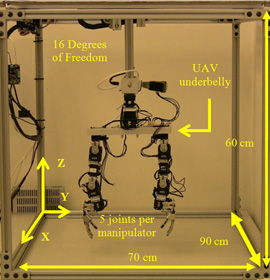By Kalwinder KaurAug 6 2012
As part of a National Science Foundation grant, Drexel University will offer robotic components to construct unmanned aerial vehicles (UAVs), similar to those being deployed in military for surveillance and reconnaissance.
 A gantry system, like the one pictured, will be used to test the robotic arms that could eventually be mounted on unmanned aerial vehicles.
A gantry system, like the one pictured, will be used to test the robotic arms that could eventually be mounted on unmanned aerial vehicles.
By discovering hovering android iconography of sci-fi movies, UAVs can be further deployed for search and rescue missions as well as for emergency response.
Led by Dr. Paul Oh of Drexel University, a team of researchers will investigate and analyze the torques and reaction forces related to implementing robotic arms for UAVs. This forms a part of work performed at Drexel Autonomous Systems Laboratory.
At present, UAVs carry out passive tasks like gathering in-flight visual data and intelligence. These are on-ground operations. The research team is discovering the potential of UAVs in interacting with objects at or beside the ground level. Another focus is the development of “Mobile Manipulating UAVs”, wherein its arms and hands can perform active near-ground tasks. These UAVs can also be deployed for varied applications such as agricultural handling, border inspection, and infrastructure repair and disaster recovery.
After receiving the three-year $649,999 grant from the NSF, the team has been challenged with creating a system, through which UAV can efficiently and steadily interact with objects. The project proposal was developed by Oh. Researchers assisting the work include Dr. Jin Kang, Dr. M. Ani Hsieh, and Dr. James Tangorra.
By retrofitting adjustable UAV-mimicking gantry system with robotic arms and hands, Oh and his team can study the forces and torques related to the motion of limbs on a flying machine. Data from the gantry testing will contribute to developing a working prototype.
Disclaimer: The views expressed here are those of the author expressed in their private capacity and do not necessarily represent the views of AZoM.com Limited T/A AZoNetwork the owner and operator of this website. This disclaimer forms part of the Terms and conditions of use of this website.